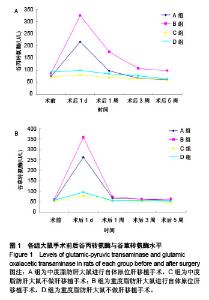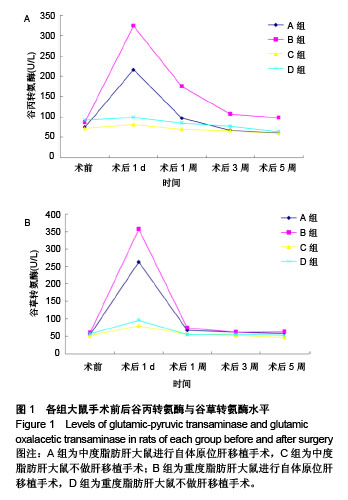Chinese Journal of Tissue Engineering Research
Previous Articles Next Articles
Lipid metabolism after autologous orthotopic liver transplantation in rat models of fatty liver
Ding Chen1, Jiang Yi2, Pan Fan2, Cai Qiucheng2
- (1Department of Hepatobiliary Surgery, the Third Affiliated Hospital of Fujian Medical University & Fujian Medical University Union Hospital, Fuzhou 350001, Fujian Province, China; 2Department of Hepatobiliary Surgery, Fuzhou General Hospital of Nanjing Military Command, Fuzhou 350025, Fujian Province, China)
-
Received:2018-08-07Online:2018-12-28Published:2018-12-28 -
Contact:Jiang Yi, MD, Professor, Doctoral supervisor, Department of Hepatobiliary Surgery, Fuzhou General Hospital of Nanjing Military Command, Fuzhou 350025, Fujian Province, China -
About author:Ding Chen, Department of Hepatobiliary Surgery, the Third Affiliated Hospital of Fujian Medical University & Fujian Medical University Union Hospital, Fuzhou 350001, Fujian Province, China -
Supported by:the Natural Science Foundation of Fujian Province, No. 2016J01592
CLC Number:
Cite this article
Ding Chen1, Jiang Yi2, Pan Fan2, Cai Qiucheng2. Lipid metabolism after autologous orthotopic liver transplantation in rat models of fatty liver [J]. Chinese Journal of Tissue Engineering Research, doi: 10.3969/j.issn.2095-4344.0560.
share this article
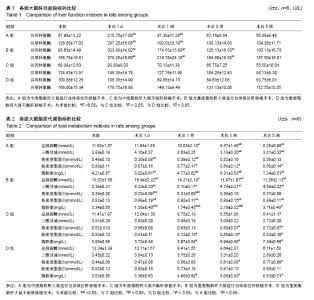
组内比较:A组术后1 d、1周的谷丙转氨酶、谷草转氨酶水平高于术前(P < 0.05);B组术后1 d、1周、3周的谷丙转氨酶、谷草转氨酶水平高于术前(P < 0.05);C、D组术后各时间点的谷丙转氨酶、谷草转氨酶水平无明显波动,提示自体肝移植后早期重度脂肪肝肝损害较中度脂肪肝 重,且恢复慢。 组间比较:与各自对照组比较,A组谷丙转氨酶和谷草转氨酶水平均于术后1 d、术后1周明显升高,B组谷丙转氨酶、谷草转氨酶水平均于术后1 d、术后1周、术后3周明显升高(P < 0.05);与A组比较,B组术后的谷丙转氨酶和谷草转氨酶水平升高,提示自体肝移植对大鼠肝功能影响大,且肝移植对重度脂肪肝较中度脂肪肝肝损害严重。 2.2.2 血清总胆固醇、三酰甘油比较 见图2,表2。4组大鼠总胆固醇和三酰甘油水平总体呈下降趋势。 组内比较:A组术后1,3,5周的总胆固醇和术后3,5周的三酰甘油低于术前(P < 0.05),B组术后1 d、1周的总胆固醇和术后1 d、1周、3周、5周的三酰甘油水平高于术前(P < 0.05),C、D组术后总胆固醇和三酰甘油较术前稍 下降或持平(P > 0.05),提示重度脂肪肝大鼠自体肝移植后 对总胆固醇和三酰甘油恢复产生较大影响。 组间比较:与C组比较,A组术后3,5周的总胆固醇和三酰甘油水平下降缓慢(P < 0.05);与D组比较,B组术后 1 d及3,5周的总胆固醇和三酰甘油水平下降缓慢(P < 0.05);与A组比较,B组术后总胆固醇和三酰甘油水平下降明显变缓(P < 0.05),提示自体肝移植对脂肪肝大鼠总胆固醇和三酰甘油产生影响,且对重度脂肪肝较中度脂肪肝影响大。 2.2.3 血清高密度脂蛋白、低密度脂蛋白比较 见图3。4组高密度脂蛋白水平总体呈升高趋势,低密度脂蛋白水平呈下降趋势。 组内比较:A、B组术后1 d、1周的高密度脂蛋白水平低于术前(P < 0.05),C、D组术后3,5周的高密度脂蛋白水平高于术前(P < 0.05);B组术后各时间点的低密度脂蛋白较术前无明显波动(P > 0.05),A、C、D组术后1,3,5周的低密度脂蛋白水平低于术前(P < 0.05)。提示重度脂肪肝大鼠自体肝移植后高、低密度脂蛋白恢复不理想。"
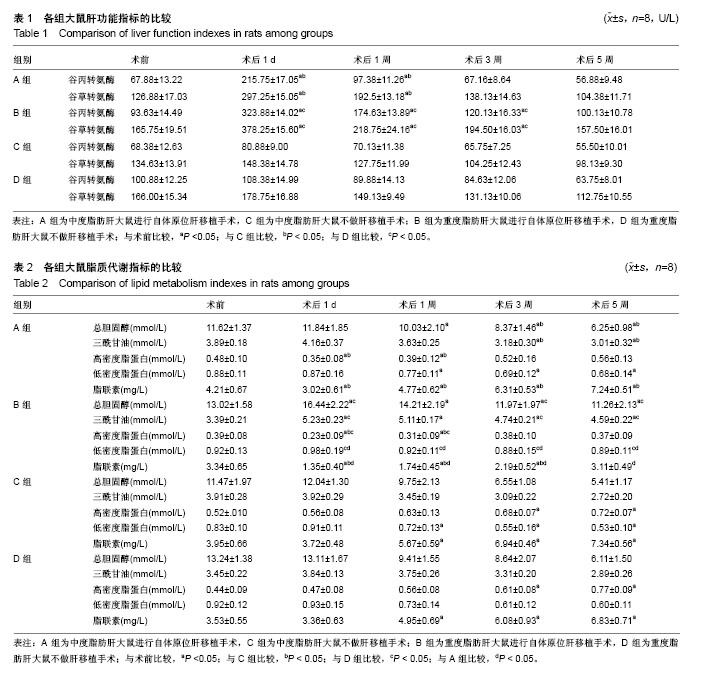
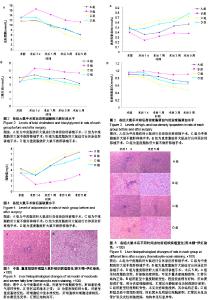
组间比较:A、B组术后1 d、术后1周的高密度脂蛋白低于各自的对照组(P < 0.05),且B组较A组更低(P < 0.05);B组术后不同时间点的低密度脂蛋白高于D、A组(P < 0.05),A组与C组相比差异无显著性意义(P > 0.05)。 2.2.4 血清脂联素总量比较 见图4,显示了4组大鼠脂联素水平总体呈上升趋势。 组内比较:A组术后1 d、1周、3周、5周的脂联素和B组术后1 d、1周、3周的脂联素水平均低于术前(P < 0.05),C、D组术后1,3,5周的脂联素水平高于术前(P < 0.05)。提示行自体肝移植后,重度脂肪肝大鼠脂联素水平下降较中度脂肪肝大鼠显著且恢复慢。 组间比较:A组术后1 d、1周、3周、5周的脂联素水平与C组比较差异显著(P < 0.05),B组术后1 d、1周、3周脂的联素水平与D组比较差异显著(P < 0.05),B组术后不同时间点的脂联素水平显著低于A组(P < 0.05)。 2.3 肝组织病理苏木精-伊红染色结果 术前病理示,A、C组肝脏呈中度脂肪变性,肝细胞轻度气球样变性,汇管区结构基本正常;B、D组肝脏呈重度脂肪变性,肝细胞轻中度水样变性,肝细胞核向细胞边缘挤压,肝血窦受压变窄,汇管区结构尚可,见图5。 ①A组:术后1 d肝脏呈中度脂肪变性,肝细胞轻度肿胀伴水样变性,肝血窦轻度扩张,汇管区内见部分炎症细胞浸润,其余结构未见明显异常;术后5周呈轻度脂肪变性,肝细胞轻度肿胀,可见少量炎症细胞浸润,汇管区结构正常;②B组:术后1 d肝脏呈重度脂肪变性,肝细胞核向细胞边缘挤压,肝细胞肿胀伴水样变性,肝腺泡内见灶状坏死,肝血窦扩张,较多红细胞淤积。间质及汇管区见大量炎症细胞浸润,毛细胆管胆汁淤积;术后5周肝脏呈中重度脂肪变性,程度较前稍有好转,肝血窦轻度扩张,部分炎症细胞浸润,汇管区内静脉淤血及轻度胆汁淤积;③C组:术后1 d肝脏呈中度脂肪变性,轻度炎症细胞浸润,汇管区结构未见明显异常;术后5周肝脏呈轻度脂肪变性,未见炎症细胞浸润,其余结构正常;④D组:术后1 d肝脏呈重度脂肪变性,轻度炎症细胞浸润,汇管区血管扩张伴淤血,肝血窦轻微扩张伴红细胞淤积;术后5周肝脏呈轻中度脂肪变性,肝血窦未见明显红细胞淤积,汇管区未见血管扩张及炎性细胞浸润,结构未见明显异常,见图6。"
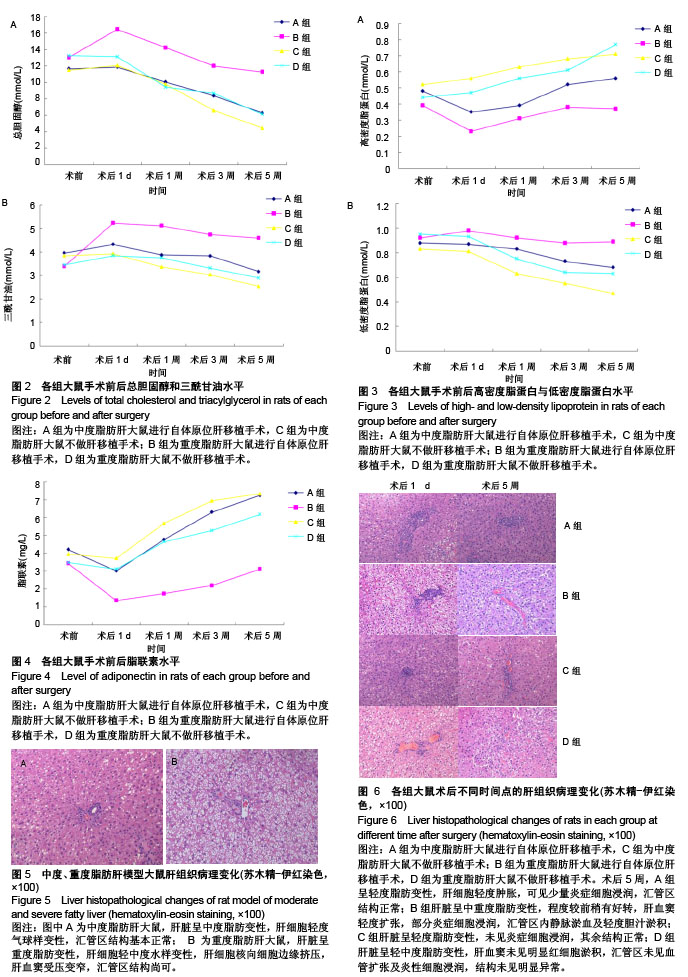
| [1] Day CP. Non-alcoholic fatty liver disease: a massive problem. Clin Med. 2011;11(2):176-178. [2] 白文元,李宁,白研.非酒精性脂肪性肝病诊治进展[J].胃肠病学, 2008, 12(12):713-716.[3] DeAiwis NM, Day CP. Non-alcoholic fatty liver disease: the mist gradually clears. J Hepatol. 2008;48(1):104-112. [4] Devisscher L, Scott CL, Lefere S, et al. Non-alcoholic steatohepatitis induces transient changes within the liver macrophage pool. Cell Immunol. 2017;(322):74-83. [5] Chackelevicius CM, Gambaro SE, Tiribel li C, et al. Th17 involvement in nonalcoholic fatty liver disease progression to non-alcoholic steatohepatitis. World J Gastroenterol. 2016; 22(41):9096-9103. [6] Lau JK, Zhang X, Yu J. Animal models of non-alcoholic fatty liver disease: current perspectives and recent advances. J Pathol. 2017; 241(1):36-44.[7] Sadler EM, Mehta N, Bhat M, et al. Liver transplantation for NASH-related hepatocellular carcinoma versus non-NASH etiologies of hepatocellular carcinoma. Transplantation. 2018;1(10):1. [8] Andert A, Becker N, Ulmer F, et al. Liver transplantation and donor body mass index>30:use or refuse? Ann Transplant. 2016;21: 185-193.[9] Croome KP, Lee DD, Keaveny AP, et al.Noneligible donors as a strategy to decrease the organ shortage. Am J Transplant. 2017;17(6): 1649-1655.[10] Ploeg RJ, D'ALESSANDRO AM, Knechtle SJ, et al. Risk factors for primary dysfunction after liver transplantation-a multivariate analysis. Transplantation. 1993;55(4):807-813. [11] 董玉茹,刘勉,马毅.探讨脂肪肝供肝在肝脏移植中的价值[J].中国CT和MRI杂志,2016,14(12):88-89.[12] 付贞,明英姿,王彦峰,等.自体肝移植技术研究进展[J].中华肝胆外科杂志,2015,21(5):354-357.[13] Dhir M, Lyden ER, Smith LM, et al. Comparison of outcomes of transplantation and resection in patients with early hepatocellular carcinoma: a meta-analysis. HPB (Oxford). 2012;14(9):635-645. [14] Canter RJ, Patel SA, Kennedy T, et al. Comparative analysi of outcome inpatients with hepatocellular carcinoma exceedin the milan criteria treated with liver transplantation versus partial hepatectomy. Am J Clin Oncol. 2011;34(5):466-471. [15] Jay C, Ladner D, Wang E, et al. A comprehensive risk assesment of mortality following donation after cardiac death liver transplantan analysis of the national registry. J Hepatol. 2011;55(4):808-813. [16] Nakamura S, Suzuki S, Konno H, et al. Resection ofmetastatic liver tumors with special reference tohepatic venous system. Hepatogastroenterology. 1998;45(19):24-28. [17] Li Y, Zhang PJ, Jin C, et al. Protective effects of deferoxamine mesylate preconditioning on pancreatic tissue in orthotopic liver autotransplantation inrats. Transplant Proc. 2011; 43(5): 1450-1455. [18] Plock J, Frese S, Keogh A, et al. Activation of non-ischemic, hypoxia-inducible signalling pathways up-regulate cytoprotective genes inthe murine liver. J Hepatol. 2007; 47(4):538-545. [19] Vernon G, Baranova A, Younossi ZM. Systematic review: the epidemiology and natural history of non‐alcoholic fatty liver disease and non-alcoholic steatohepatitis in adults. Aliment Pharmacol Ther. 2011;34(3):274-285. [20] Pascale A, Pais R, Ratziu V. An overview of nonalcoholic steatohepatitis: past, present and future directions. J Gastrointestin Liver Dis. 2010;19(4):415-423. [21] Zhong Z, Lemasters JJ. Role of free radicals in failure of fatty liver grafts caused by ethanol. Alcohol. 2004;34(1):49-58. [22] 梁绍勇.肝再生增强因子防治大鼠肝移植急性排斥反应实验研究[D].重庆:重庆医科大学,2008.[23] Erridge C. Diet, commensals and the intestine as sources of pathogen-associated molecular patterns in atherosclerosis, type 2 diabetes and non-alcoholic fatty liver disease. Atherosclerosis. 2011; 216(1):1-6. [24] 王少真,徐延光,史亚男.马来酸罗格列酮联合小剂量二甲双胍和那格列奈改善胰岛素抵抗对糖尿病前期伴非酒精性单纯性脂肪肝的逆转作用[J].中国全科医学,2009,12(5):729-731.[25] Chavez-apia NC, Tiribelli C. Are non-invasive tests accurate enough to predict hepatic fibrosis in non-alcoholic fatty liver disease(NAFLD)Gut. 2008;57:1351-1353.[26] Xi n YN, Xuan SY, Guan HS. Leptin: is it a possible specific liver drug for non-alcoholic fatty liver disease(NAFLD).Med Hypot Heses. 2008; 71:462-463.[27] 范建高.糖尿病与肝病的关系及其诊治对策[J].中华糖尿病杂志, 2009, 1(4):244-247.[28] Torres DM, Harrison SA. Diagnosis and therapy of nonalcoholic steatohepatitis. Gastroenterology. 2008;134:1682-1698.[29] Pagano C, Soardo G, Esposito W, et al. Plasma adiponectin is decrease in nonalcoholic fatty liver disease. Eur J Endoerinol. 2005; 152:113-118. [30] Ali R, Cnsi K. New diagnostic and treatment approaches in non-alcoho1ic fatty liver disease(NAFLD). Ann Med. 2009;41: 265-278.[31] 皇甫竞坤,闫杰,王艳斌,等.血清脂联素水平与非酒精性脂肪性肝病相关性研究[J].中华临床医师杂志(电子版), 2013,7(7): 2852-2855. |
| [1] | Zhang Tongtong, Wang Zhonghua, Wen Jie, Song Yuxin, Liu Lin. Application of three-dimensional printing model in surgical resection and reconstruction of cervical tumor [J]. Chinese Journal of Tissue Engineering Research, 2021, 25(9): 1335-1339. |
| [2] | Zeng Yanhua, Hao Yanlei. In vitro culture and purification of Schwann cells: a systematic review [J]. Chinese Journal of Tissue Engineering Research, 2021, 25(7): 1135-1141. |
| [3] | Xu Dongzi, Zhang Ting, Ouyang Zhaolian. The global competitive situation of cardiac tissue engineering based on patent analysis [J]. Chinese Journal of Tissue Engineering Research, 2021, 25(5): 807-812. |
| [4] | Wu Zijian, Hu Zhaoduan, Xie Youqiong, Wang Feng, Li Jia, Li Bocun, Cai Guowei, Peng Rui. Three-dimensional printing technology and bone tissue engineering research: literature metrology and visual analysis of research hotspots [J]. Chinese Journal of Tissue Engineering Research, 2021, 25(4): 564-569. |
| [5] | Chang Wenliao, Zhao Jie, Sun Xiaoliang, Wang Kun, Wu Guofeng, Zhou Jian, Li Shuxiang, Sun Han. Material selection, theoretical design and biomimetic function of artificial periosteum [J]. Chinese Journal of Tissue Engineering Research, 2021, 25(4): 600-606. |
| [6] | Liu Fei, Cui Yutao, Liu He. Advantages and problems of local antibiotic delivery system in the treatment of osteomyelitis [J]. Chinese Journal of Tissue Engineering Research, 2021, 25(4): 614-620. |
| [7] | Li Xiaozhuang, Duan Hao, Wang Weizhou, Tang Zhihong, Wang Yanghao, He Fei. Application of bone tissue engineering materials in the treatment of bone defect diseases in vivo [J]. Chinese Journal of Tissue Engineering Research, 2021, 25(4): 626-631. |
| [8] | Zhang Zhenkun, Li Zhe, Li Ya, Wang Yingying, Wang Yaping, Zhou Xinkui, Ma Shanshan, Guan Fangxia. Application of alginate based hydrogels/dressings in wound healing: sustained, dynamic and sequential release [J]. Chinese Journal of Tissue Engineering Research, 2021, 25(4): 638-643. |
| [9] | Chen Jiana, Qiu Yanling, Nie Minhai, Liu Xuqian. Tissue engineering scaffolds in repairing oral and maxillofacial soft tissue defects [J]. Chinese Journal of Tissue Engineering Research, 2021, 25(4): 644-650. |
| [10] | Xing Hao, Zhang Yonghong, Wang Dong. Advantages and disadvantages of repairing large-segment bone defect [J]. Chinese Journal of Tissue Engineering Research, 2021, 25(3): 426-430. |
| [11] | Gao Shan, Huang Dongjing, Hong Haiman, Jia Jingqiao, Meng Fei. Comparison on the curative effect of human placenta-derived mesenchymal stem cells and induced islet-like cells in gestational diabetes mellitus rats [J]. Chinese Journal of Tissue Engineering Research, 2021, 25(25): 3981-3987. |
| [12] | Fan Junchao, Chen Yong, Song Junjie. Sevoflurance combined with xenon pretreatment protects against spinal cord ischemia-reperfusion injury in a rat model [J]. Chinese Journal of Tissue Engineering Research, 2021, 25(23): 3660-3665. |
| [13] | Zhu Rui, Zeng Qing, Huang Guozhi. Ferroptosis and stroke [J]. Chinese Journal of Tissue Engineering Research, 2021, 25(23): 3734-3739. |
| [14] | Chen Siqi, Xian Debin, Xu Rongsheng, Qin Zhongjie, Zhang Lei, Xia Delin. Effects of bone marrow mesenchymal stem cells and human umbilical vein endothelial cells combined with hydroxyapatite-tricalcium phosphate scaffolds on early angiogenesis in skull defect repair in rats [J]. Chinese Journal of Tissue Engineering Research, 2021, 25(22): 3458-3465. |
| [15] | Wang Hao, Chen Mingxue, Li Junkang, Luo Xujiang, Peng Liqing, Li Huo, Huang Bo, Tian Guangzhao, Liu Shuyun, Sui Xiang, Huang Jingxiang, Guo Quanyi, Lu Xiaobo. Decellularized porcine skin matrix for tissue-engineered meniscus scaffold [J]. Chinese Journal of Tissue Engineering Research, 2021, 25(22): 3473-3478. |
| Viewed | ||||||
|
Full text |
|
|||||
|
Abstract |
|
|||||
